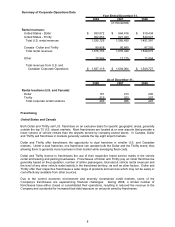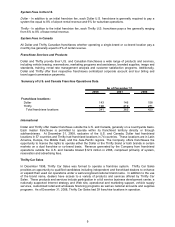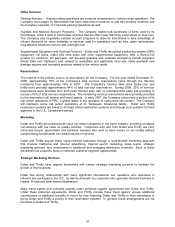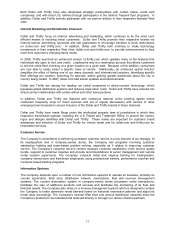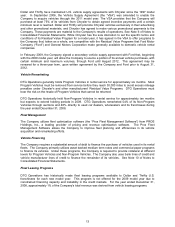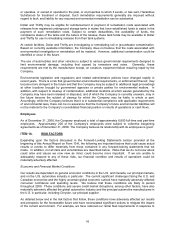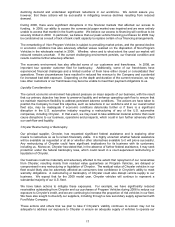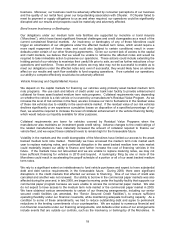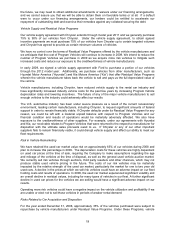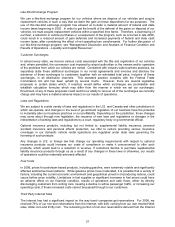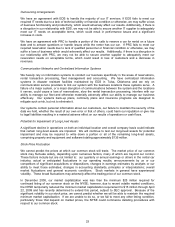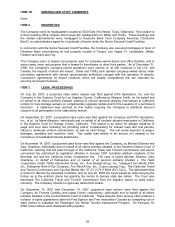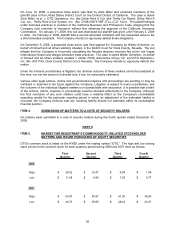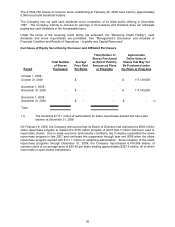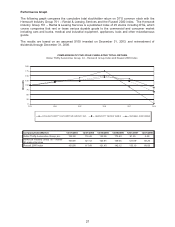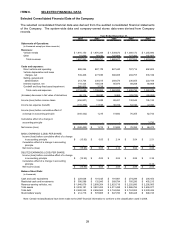Thrifty Car Rental 2008 Annual Report Download - page 20
Download and view the complete annual report
Please find page 20 of the 2008 Thrifty Car Rental annual report below. You can navigate through the pages in the report by either clicking on the pages listed below, or by using the keyword search tool below to find specific information within the annual report.business. Moreover, our business could be adversely affected by consumer perceptions of our business
and the quality of our rental fleet, given our long-standing association with Chrysler. If Chrysler failed to
meet its payment or supply obligations to us as and when required, our operations could be significantly
disrupted and our results and prospects could be materially and adversely affected.
Bond Insurer Insolvency or Bankruptcy
Our obligations under our medium term note facilities are supported by monoline or bond insurers
(“Monolines”), which have faced significant financial challenges and credit downgrades as a result of the
current constrained financial markets. An insolvency or bankruptcy of any of these Monolines could
trigger an amortization of our obligations under the affected medium term notes, which would require a
more rapid repayment of those notes, and could also (subject to certain conditions) result in cross-
defaults under certain of our other financing agreements. Given our current lack of access to the capital
and credit markets, we believe that we would be unable to refinance the affected notes and would be
required to take immediate action to preserve our operations. These actions could include extending the
holding period of our vehicles to maximize their useful life prior to sale, as well as further reductions of our
operations and workforce. These and other actions we may take may not be successful to enable us to
meet our obligations under the affected notes and, even if successful, they would likely have an adverse
affect on our results and cash flow available to fund ongoing operations. If we curtailed our operations,
our ability to compete effectively would also be adversely affected.
Vehicle Financing and Capital Market Access
We depend on the capital markets for financing our vehicles using primarily asset backed medium term
note programs. We use cash and letters of credit under our bank loan facility to provide enhancement
collateral for these asset backed medium term note programs. Collateral requirements vary depending
on whether the vehicle is a risk vehicle or is covered by a manufacturer’s Residual Value Program. As we
increase the level of risk vehicles in the fleet, we also increase our risk to fluctuations in the residual value
of those risk vehicles due to volatility in the used vehicle market. If the residual value of our risk vehicles
declines significantly or we experience cumulative losses on disposition of a specified percentage of our
fleet, we would be required to increase the level of collateral enhancement in the vehicle financing facility,
which would reduce our liquidity available for other purposes.
Collateral requirements are lower for vehicles covered by Residual Value Programs when the
manufacturer also maintains an investment grade credit rating. Adverse changes to the credit ratings of
the related manufacturers have materially increased the amount of collateral required to finance our
vehicle fleet, and we expect these collateral levels to remain high for the foreseeable future.
Volatility in the markets and the credit downgrades of the Monolines have limited our access to the asset
backed medium term note market. Historically we have accessed the medium term note market each
year to replace maturing notes, and continued disruption in the asset backed medium term note market
could materially impact our ability to finance and further increase the cost of financing vehicles in the
future. If the markets have not rebounded and we are unable to replace maturing notes, we may not
have sufficient financing for vehicles in 2010 and beyond. A bankruptcy filing by one or more of the
Monolines could result in accelerating the payoff schedule of a portion or all of our asset backed medium
term notes.
We rely to a significant extent on indebtedness to fund vehicle purchases and expect to have substantial
debt and debt service requirements in the foreseeable future. During 2008, there were significant
disruptions in the credit markets that affected our access to financing. One of our lines of credit was
cancelled and another was not renewed. Our ability to borrow in the commercial paper markets was also
affected during the year and, in late 2008, we began borrowing under the liquidity facility that supports our
commercial paper program because we were unable to access the commercial paper market. We also
do not expect to have access to the medium term note market or the commercial paper market in 2009.
We have obtained various amendments to certain of our financing arrangements, including our senior
secured credit facilities (as amended, the “Senior Secured Credit Facilities”), to ensure sufficient
operating flexibility under our financial covenants, while maintaining adequate borrowing capacity. As a
condition to some of these amendments, we had to reduce outstanding debt and agree to permanent
reductions in the lending commitments of our counterparties. We are subject to numerous financial and
non-financial covenants under our financing arrangements, and defaults under some of our arrangements
include events that are outside our controls, such as the insolvency or bankruptcy of the Monolines. In
18


